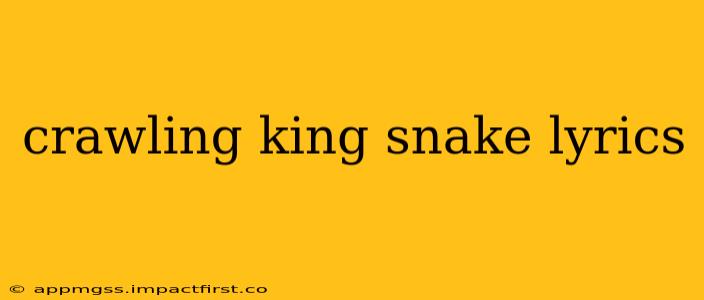The song "Crawling King Snake" is a blues classic, known for its raw energy and unforgettable riff. But what does it actually mean? The lyrics, often interpreted as metaphorical, leave room for multiple understandings. Let's delve into the song's history, explore various interpretations, and answer some common questions about this blues staple.
Who wrote Crawling King Snake?
The authorship of "Crawling King Snake" is shrouded in some mystery, although it's most commonly attributed to John Lee Hooker. He popularized the song, and his version is arguably the most famous. However, the exact origins are debated, with some attributing earlier versions to other blues artists. This ambiguity only adds to the song's mystique.
What's the meaning behind the lyrics?
The lyrics are cryptic and open to interpretation, making it a fertile ground for analysis. The "crawling king snake" is often seen as a metaphor for:
- A deceitful or dangerous person: The snake's stealthy nature and potential for harm mirrors treacherous individuals.
- Difficult circumstances or hardship: The slow, persistent movement of the snake can represent the relentless nature of trouble.
- A relentless pursuit: The snake's pursuit of its prey could be a metaphor for an unrelenting problem or an obsessive desire.
The song's overall tone is one of warning and defiance, implying a struggle against adversity. The repetition of certain lines enhances this feeling of struggle and determination.
Frequently Asked Questions about "Crawling King Snake"
Here, we tackle some frequently asked questions surrounding the song:
What are the most famous versions of "Crawling King Snake"?
John Lee Hooker's version is undoubtedly the most well-known and influential. However, many artists have covered the song, each adding their own unique interpretation. Notable renditions include those by the Rolling Stones, who featured it on their album Sticky Fingers, and numerous other blues and rock artists. Each version highlights different aspects of the song's versatility.
What is the musical structure and style of "Crawling King Snake"?
The song typically follows a twelve-bar blues structure, characteristic of much blues music. It's known for its repetitive, hypnotic riff and Hooker's distinctive vocals, which add a powerful, gritty tone to the song. Its simplicity belies its emotional depth, making it both catchy and deeply resonant.
How has "Crawling King Snake" impacted music history?
"Crawling King Snake" has had a significant impact on music history. Its influence can be heard in countless blues, rock, and even contemporary music songs. Its enduring popularity speaks to its timeless themes and powerful musicality, securing its place as a blues classic. Its use of repetition, minimalist approach, and direct emotional expression has inspired musicians for generations.
What instruments are typically used in "Crawling King Snake"?
The song typically features a strong guitar riff, usually played on an electric guitar, often accompanied by bass and drums. John Lee Hooker's versions often featured a harmonica as well, adding another layer of bluesy texture. Variations certainly exist, depending on the artist and the specific arrangement.
By exploring the lyrical ambiguity and musical structure, along with the varied interpretations and enduring legacy of "Crawling King Snake," we gain a deeper appreciation for its enduring power and impact on music history. The song remains a testament to the enduring appeal of blues music and its ability to convey profound emotions with deceptively simple means.
